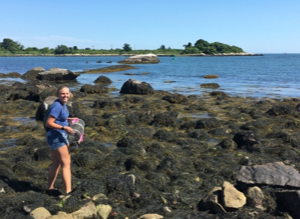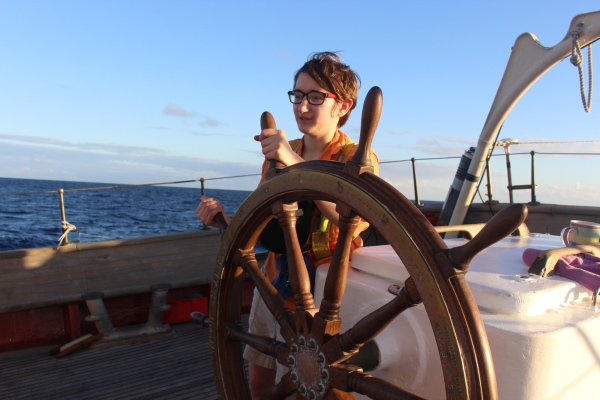This post was written by S’18 alumna Audra DeLaney. Audra enjoys visiting the ocean, going on adventures, and telling the unique stories of the people and places around her.
Each summer, a few students from previous Williams-Mystic classes, or from Williams College, live in Mystic while conducting scientific research. This summer, those individuals were Shelby Hoogland (Bryn Mawr College ‘19), Cristina Mancilla (Williams College ‘20), and Caroline Hung (Williams College ‘19). Here is what they have to say about their research:
Shelby (S’18)
Shelby wrote this for a Bryn Mawr College publication.
When I first moved back to Mystic, Connecticut, I had a preconceived notion of what my summer was going to look like after having spent the past semester with the Williams-Mystic Maritime Studies Program. My best friend from the program was going to be my roommate, I would be living in a student house, and would be working with the same professors from the semester.
I’ve traveled with these professors across the country — from sailing offshore in the Caribbean Sea aboard the SSV Corwith Cramer to hearing how climate change is affecting the lives and the history of the Grand Caillou/Dulac Band of Biloxi-Chitimacha-Choctaw Indians in Southern Louisiana.  If you know nothing about Williams-Mystic, know that the 30 other people you get thrown together with, students and faculty alike, become your family for a semester. I already had a few important connections: with Dr. Tim Pusack, my former marine ecology professor and current research mentor; with Dr. Rachel Scudder, my former oceanography professor; and with another current research mentor. These connections helped make me more confident that this would be the summer where I grow into my new position in life as a field ecologist and as a research scientist.
If you know nothing about Williams-Mystic, know that the 30 other people you get thrown together with, students and faculty alike, become your family for a semester. I already had a few important connections: with Dr. Tim Pusack, my former marine ecology professor and current research mentor; with Dr. Rachel Scudder, my former oceanography professor; and with another current research mentor. These connections helped make me more confident that this would be the summer where I grow into my new position in life as a field ecologist and as a research scientist.
Invasive species pose one of the largest threats to biodiversity worldwide. Additionally, a group of invasive organisms can alter an ecosystem’s characteristics and local populations of native species. These alterations can directly impact local economies, negatively affecting industries such as tourism or commercial fishing.
C. maenas is an introduced crab species originally from coastal Europe that was potentially brought over in the fouling or bored into a wooden ship in the 1800s. The area that I have been studying is Avery Point, Connecticut on the University of Connecticut – Avery Point’s campus. Although there are many different crabs found in this rocky intertidal ecosystem, the shoreline is dominated by C. maenas. It can be assumed that it is outcompeting native populations of crabs and other invasive species of crabs. In the lab, I am subjecting the crabs to temperatures between 12˚C and 31˚C to mimic the rising temperatures that will be present during the coming years due to climate change. I am measuring their daily feeding rates as a direct measure of their response to the temperature stress.
 My research has brought me to some really cool places. How often can someone say that they get to go to the beach for their job? More importantly, it has taught me the importance of studying climate change. And it has given me insight into how little we currently know about how climate change might affect vital ecosystems. Looking forward to the future, the uncertainty is high as to what our climate will be like. Additionally, we don’t exactly know how it is going to influence local economies. Funding climate change research is important so that we can better prepare our communities in the face of future disasters.
My research has brought me to some really cool places. How often can someone say that they get to go to the beach for their job? More importantly, it has taught me the importance of studying climate change. And it has given me insight into how little we currently know about how climate change might affect vital ecosystems. Looking forward to the future, the uncertainty is high as to what our climate will be like. Additionally, we don’t exactly know how it is going to influence local economies. Funding climate change research is important so that we can better prepare our communities in the face of future disasters.
Cristina (S’18)
I researched trends in population growth and movement of Mnemiopsis leidyi, a comb jellyfish, throughout the Mystic River Estuary and the Long Island Sound. Another component of my research was to figure out a way to keep comb jellyfish alive in the laboratory in order to study them in a controlled setting. This was the most difficult part of the research. M. leidyi are notoriously difficult to maintain in a lab, but I needed to come up with a method to keep them alive long enough to complete an experiment. After much trial and error and with the help of other researchers, I was glad to finally have kept the comb jellyfish alive for a sustained period of time. The work that I did over the summer will hopefully make studying M. leidyi in the laboratory an option for future Williams-Mystic students. I wish to continue this project by studying the effect of increasing temperature on the reinfection rate of M. leidyi by a sea anemone larvae.
Caroline (Williams College Student)
The summer of 2018 was Caroline’s third summer researching with Associate Professor of Geosciences and Marine Science Lisa Gilbert (S’96).
What I researched:
There are two projects I’ve been working on in my 10-week time with Lisa this summer. I spend most of my time working on my thesis, which is using geochemistry and petrology to find out the origins of the volcanic and alteration setting of the Chrystalls Beach Metabasalt Formation. We spent three weeks at the beginning of summer at our field site on Taieri Beach in South Island, New Zealand. Right now, we are focusing on analyzing the samples and starting to discuss the results. This effort will continue into my senior year. The other project is trying to finish my manuscript on marsh erosion — a project Lisa and I have worked on the past two summers at a local marsh in Barn Island. We hope to submit the manuscript by the end of August.

What I learned:
I learn so much working with Lisa. It’s finally a chance to apply what I learn in geosciences classes in the field and research. Fieldwork and learning the scientific research process are like courses of them own. I have just started to become a so-called “hard-rock” geoscientist, meaning I now focus on subjects such as tectonics, volcanoes, geophysics, and structural geology, as opposed to “soft-rock” geology, which primarily focuses on fossils, oceanography, geomorphology.
Being out in the field in New Zealand was a challenge every day. I had to learn a lot of field mapping and measuring techniques right on the spot. Lisa was super supportive even when it took me an entire field day to learn how to measure strike and dip (the technical and accepted way to measure the orientation of rocks). But research allows me to build firm foundations on my science knowledge and to really tie what I learn in the classroom and from scientific research together.
I also learned that I want to keep doing what I do in the summers after graduation. Thus, I’m applying to graduate schools in earth sciences!
Challenges:
It takes a lot to focus on the same project knowing that you will continue to work on it the following year. Sometimes, people work in the same area for the rest of their lives! I try to mix up my days and weeks focusing on individual aspects of the project one at a time; I’ll read papers in the morning and play with data in the afternoon, or go to the field in the morning and do lab work and prep in the afternoon. Often, I still find myself staring at the computer because I couldn’t understand the numbers or try to troubleshoot with software or math. I just try to stay positive and know that at some point I will work through my problems. That is when research becomes very satisfying — when you figure out the answer to a problem that you’ve spent days working on.

Favorite part:
Fish and chips after field work at a roadside shack in New Zealand. Also, Lisa gives me a lot of autonomy in my work. From how I want to schedule my work day and the research questions I ask, to how I want to answer them. But she is very good at guiding me and giving me hints and critiques that I always look back on and am so thankful for! One of the greatest inspiration and fulfillment for why I want to keep working in Geosciences is the layout of this work that Lisa has got me started on. She always leads me in a good direction — I honestly don’t know where my life will be right now without stumbling into her lab the first summer after freshman year!





 If you know nothing about Williams-Mystic, know that the 30 other people you get thrown together with, students and faculty alike, become your family for a semester. I already had a few important connections: with Dr. Tim Pusack, my former marine ecology professor and current research mentor; with Dr. Rachel Scudder, my former oceanography professor; and with another current research mentor. These connections helped make me more confident that this would be the summer where I grow into my new position in life as a field ecologist and as a research scientist.
If you know nothing about Williams-Mystic, know that the 30 other people you get thrown together with, students and faculty alike, become your family for a semester. I already had a few important connections: with Dr. Tim Pusack, my former marine ecology professor and current research mentor; with Dr. Rachel Scudder, my former oceanography professor; and with another current research mentor. These connections helped make me more confident that this would be the summer where I grow into my new position in life as a field ecologist and as a research scientist. My research has brought me to some really cool places. How often can someone say that they get to go to the beach for their job? More importantly, it has taught me the importance of studying climate change. And it has given me insight into how little we currently know about how climate change might affect vital ecosystems. Looking forward to the future, the uncertainty is high as to what our climate will be like. Additionally, we don’t exactly know how it is going to influence local economies. Funding climate change research is important so that we can better prepare our communities in the face of future disasters.
My research has brought me to some really cool places. How often can someone say that they get to go to the beach for their job? More importantly, it has taught me the importance of studying climate change. And it has given me insight into how little we currently know about how climate change might affect vital ecosystems. Looking forward to the future, the uncertainty is high as to what our climate will be like. Additionally, we don’t exactly know how it is going to influence local economies. Funding climate change research is important so that we can better prepare our communities in the face of future disasters.
